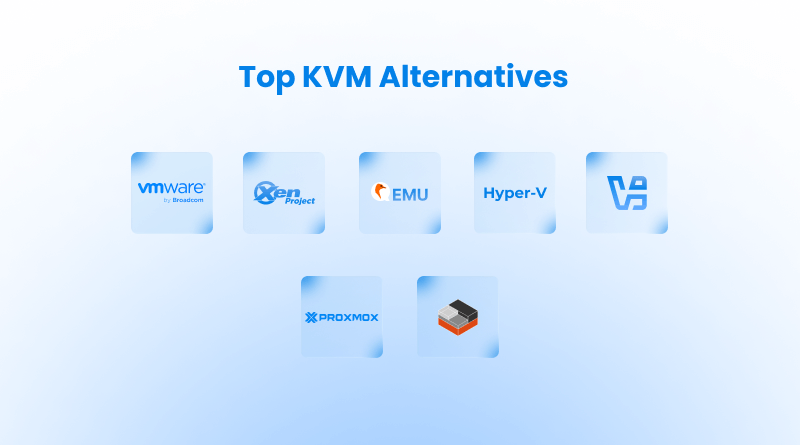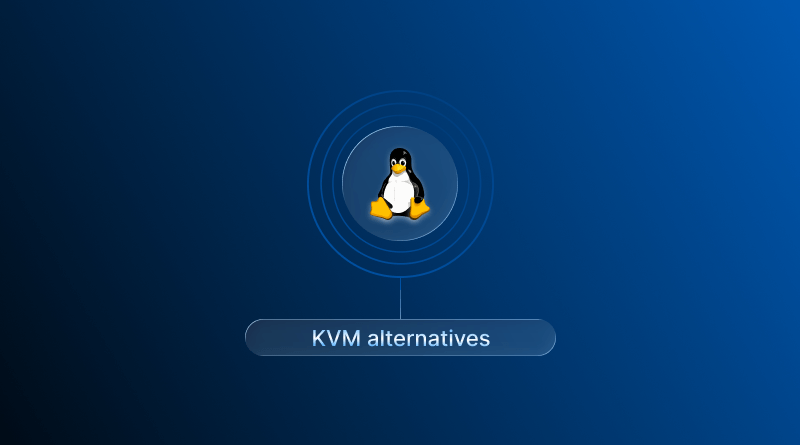When it comes to virtualization, KVM (Kernel-based Virtual Machine) is recognized as one of the leading hypervisors in the open-source ecosystem.
Being part of the Linux kernel, KVM provides bare-metal performance with complete control and no licensing fees, which explains why it is used as a foundation for several cloud and enterprise infrastructures. Many developers and enterprises prefer KVM VPS hosting because it delivers near-native performance with full root access, making it ideal for high-performance web applications and business-critical workloads.
Sometimes, the tool that gives you the most control also demands the most effort, and that’s exactly where many start looking for KVM alternatives. As your organization’s IT environment gets more complex, simpler management tools, cross-platform interoperability, or higher-level vendor support beyond the KVM ecosystem can become necessary. In such cases, KVM is not able to keep up with every organization’s growing demands.
Virtualization technology has matured, and many new alternatives to hypervisors of Type 1 have emerged, each with its own benefits. For example, VMware ESXi has enterprise-level dependability, Hyper-V seamlessly integrates with Windows, and Proxmox VE is open-source and uncomplicated. Each alternative has a unique take on performance, ease of use, and scalability.
In this hypervisor comparison blog, we will consider KVM’s competitors and evaluate them on management efficiency, secure isolation, resource utilization, and enterprise readiness.
Table Of Content
Why Do People Seek KVM Alternatives? Ahead of Competitive Edge
Before discussing the best alternatives to KVM, it is worthwhile to describe what makes KVM such a formidable competitor within virtualization technology and the reasons why users eventually look for alternatives. In fact, KVM powers a large segment of modern VPS hosting solutions for businesses transitioning from shared hosting to more controlled environments.
KVM (Kernel-based Virtual Machine) is an open-source Type 1 hypervisor that is built directly into the Linux kernel. It turns Linux systems into powerful hosts that can support running many isolated virtual machines (VMs), which KVM can support running with almost native performance. This deep kernel integration allows KVM to gain almost unrivaled performance, particularly for Linux-heavy and data center workload deployments, where speed and resource efficiency are paramount.
Similar Read: How Virtualization Benefits Your Business
KVM’s unique features can also be attributed to the fact that it is open-source, which means no vendor lock-in and no licensing fees. KVM’s Type 1 architecture guarantees low latency and overhead, as well as excellent Intel VT-x and AMD-V extensions virtualization. KVM-based virtual machines are able to operate almost as fast as physical machines, which makes KVM ideal for enterprises, developers, and cloud service providers who wish to gain full control without added costs.
Furthermore, enterprise support for KVM is offered by third-party Linux vendors like Red Hat Enterprise Linux (RHEL) or SUSE, and not the KVM project itself, making setup and long-term upkeep more piecemeal. This can work against organizations that prefer a unified, cohesive virtualization strategy.
Best Type 1 Hypervisor Alternatives to KVM
KVM is undoubtedly the most flexible and high-performing open-source hypervisor, yet other options provide KVM with a run for its money in ease of use, integration, and enterprise features. Here is a little breakdown of KVM vs. its biggest competitors.

1. KVM Alternative: VMware
- Ideal for: Enterprises seeking top-tier performance, professional support, and enterprise management tools.
- KVM vs. VMware: As one of the oldest virtualization solutions, VMware offers advanced features like vMotion, DRS, and vSAN integration, and it continues to provide enterprise workloads with unparalleled stability and scalability. However, it is important to note that licensing costs are significantly higher compared to KVM, which is open source and more affordable. Organizations that value uptime, infrastructure, support, and management are best served by the VMware ecosystem.
2. KVM Alternative: Xen
- Ideal for: Cloud infrastructures and environments that require strong isolation.
- KVM vs Xen: Xen is a highly popular open-source hypervisor, especially in large-scale cloud platforms that include AWS. Its support for paravirtualization and hardware-assisted virtualization offers exceptional security and isolation. Even though KVM is less complex to operate on Linux systems, Xen is preferred in multi-tenant environments and configurations that require advanced security for sensitive workloads.
3. KVM Alternative: QEMU
- Ideal for: Developers and testers looking for full system emulation and a wide range of flexibility.
- KVM vs. QEMU: QEMU is highly valuable for those looking to test different operating systems and cross-platform applications due to its ability to emulate virtually any hardware architecture. Along with KVM, QEMU can take advantage of hardware acceleration for near-native performance. KVM can be used separately. Still, it will be slower than expected; that is why KVM and QEMU are used together for optimal efficiency.
4. KVM Alternative: Hyper-V
- Ideal for: Businesses utilizing a Microsoft Windows infrastructure.
- KVM vs Hyper-V: Hyper-V can integrate and manage Windows Server and Windows 10/11 Pro editions. It can manage GUIs and integrate Windows Active Directory. Hyper-V is also great for companies that manage significant Microsoft infrastructure and are able to support Type 1 and Type 2 virtualization. Compared to KVM and Linux workloads, Hyper-V is less flexible.
5. KVM Alternative: VirtualBox
- Ideal for: Students, developers, and small testing environments.
- KVM vs VirtualBox: VirtualBox is easy to use and install, especially for beginners in educational and development environments. However, it’s not appropriate for high-performance, production environments. Unlike VirtualBox, KVM provides performance, resource distribution, and scalability, which are necessary for servers and enterprise applications.
6. KVM Alternative: Proxmox
- Ideal for: Users looking for a comprehensive virtualization and container management console.
- KVM vs Proxmox: Proxmox VE synergizes KVM and LXC, enabling users to control VMs and containers through a single web console. It streamlines network configuration, backups, and cluster management, making it highly versatile for home labs and business settings. While KVM serves as the underlying hypervisor, Proxmox’s improvements in management and control usability are appreciated.
7. KVM Alternative: ESXi
- Ideal for: Businesses that place high value on support, reliability, and stability.
- KVM vs. ESXi: VMware ESXi, which is one of the vSphere products, is considered one of the most efficient and easy-to-deploy commercial hypervisors. It possesses advanced instruments for high availability and disaster recovery as well. KVM, in so many instances, rivals the performance of ESXi, but ESXi presents superior integration with the rest of the VMware products, which is beneficial for businesses that require consolidated management and 24/7 support from the vendor.
8. KVM Alternative: LXC
- Ideal for: Lightweight and resource-efficient setups running multiple isolated workloads.
- KVM vs. LXC: LXC provides containerization at the operating system level by sharing the host kernel and isolating applications. It is quicker to boot, more resource-efficient, and works well for high-density microservice workloads. KVM, on the other hand, offers better isolation because every virtual machine runs its own kernel. In addition, KVM is better suited for applications that require strong security, control of a complete operating system, and robust isolation.
KVM Alternatives: Performance and Management Comparison
| Virtualization Platform | Performance Efficiency | Resource Utilization | Management Interface | Scalability |
| KVM | Near-native performance with hardware acceleration | Efficient with direct kernel integration | Command-line and third-party tools like Virt-Manager or Cockpit | Highly scalable for enterprise workloads |
| VMware ESXi | Excellent, enterprise-grade optimization | Balanced and reliable | vSphere client with centralized management | Exceptional for large infrastructures |
| Xen | High performance for multi-tenant setups | Moderate to high, depending on configuration | CLI and XenCenter GUI | Strong scalability in cloud deployments |
| QEMU | Moderate (high with KVM acceleration) | CPU-intensive without KVM | Command-line interface, flexible configuration | Limited scalability standalone |
| Hyper-V | Strong, optimized for Windows workloads | Efficient in Windows ecosystems | Hyper-V Manager & PowerShell | Good scalability with cluster support |
| VirtualBox | Moderate for desktop-level tasks | Moderate, depends on host system | GUI-based, simple to use | Limited to single systems |
| Proxmox VE | Excellent (uses KVM + LXC combo) | Optimized for containers and VMs | Intuitive web GUI | Highly scalable with cluster setup |
| LXC | Extremely fast startup and execution | Very low overhead (container-based) | Command-line and Proxmox/LXD front-end | Scales efficiently for lightweight workloads |
As the demands for KVM infrastructure grow, looking into the best KVM alternatives like Proxmox VE, VMware ESXi, and Hyper-V becomes necessary. Performance and the value of open-source availability to developers, enterprises, and cloud providers, KVM remains in the top position of popularity within the rapidly changing field of virtualization. Each of those hypervisors has its unique advantages: Proxmox provides integrated management, ESXi offers enterprise-grade reliability, and Hyper-V offers seamless integration with Windows OS, an advantage particularly for Windows-focused cloud providers.
Your priorities, whether cost-efficiency, manageability, vendor support, or the ultimate deciding factor, scalability, will help you choose the right hypervisor. Whether you run an eCommerce store or manage multiple client websites, choosing the right hypervisor directly impacts your overall web hosting performance, uptime, and management flexibility. Balancing between KVM’s open ecosystem and a rich-featured alternative, modern virtualization provides the speed, reliability, and flexibility you need, no matter the scale.
FAQs
1. What is the best KVM alternative for a small-to-medium business (SMB) environment?
For SMBs, Proxmox VE is the best KVM alternative. It combines KVM for virtualization and LXC for containers in a unified, effortless web interface. Proxmox is tailored for small-to-medium business setups. It offers a wonderful blend of performance, simplicity, and scalability while enabling small teams to utilize enterprise-grade tools such as clustering, backups, and resource monitoring without the intricacy and high cost of licensing and commercial hypervisors.
2. Is there a free, open-source hypervisor that offers better management tools than KVM?
Yes, Proxmox VE leads the industry once again. Proxmox builds on KVM, providing an integrated GUI, role-based access control, and centralized monitoring so KVM users don’t have to rely on third-party tools or command-line management. For those in need of a powerful free open-source virtualization platform that offers intuitive management and control, Proxmox is far easier than working with a standalone KVM environment.
3. How do hypervisor alternatives like Hyper-V and ESXi compare to KVM in performance?
KVM, Hyper-V, and VMware ESXi achieve comparable native speeds on VMs because of hardware-assisted virtualization. However, Hyper-V and ESXi are fine-tuned for enterprise workloads and provide stronger integration with operational management layers and automated resource handling. KVM, on the flip side, is a lightweight virtualization solution that runs very efficiently in a linux environment, thereby making it suitable for developers and businesses that prioritize open-source virtualization.
4. KVM vs. VMware ESXi: Which hypervisor is better for a high-availability, enterprise environment?
When it comes to high-availability enterprise environments, VMware ESXi, on most occasions, outperforms KVM. This is primarily due to its mature ecosystem, professional backing, and enterprise management flexibilities through vCenter and vSphere. The critical nature of work is highly dependent on ESXi’s advanced features like vMotion, DRS, and built-in redundancy. However, for enterprises, acceptably KVM along with management tools like oVirt or Proxmox, is a strong open-source alternative.








